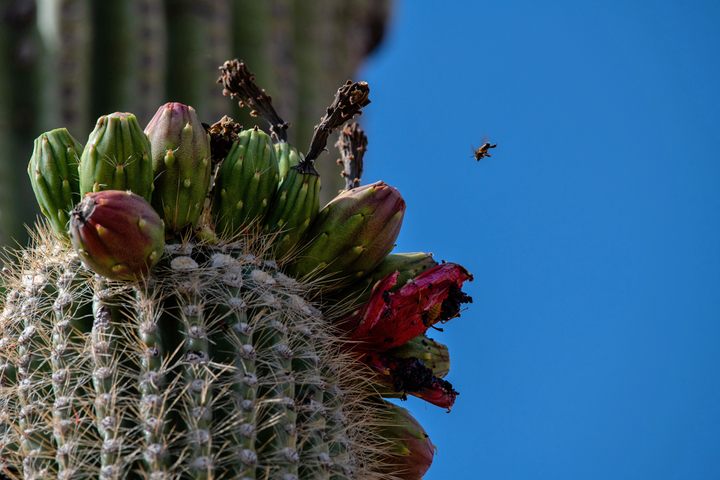

The Ancient Art of Harvesting Fruit in the Desert
Treasured by the Tohono O’odham, saguaro fruit appear only in the Sonoran summer.
Noland Johnson aims his kuipad, reaching the 20-foot pole made of sun-bleached saguaro cactus ribs that bends under its own weight. His target is also a saguaro, this one living and rising some two stories into the desert sky. He slides the sharp tip of the kuipad behind one of the cactus’s arms, which is crowned with bulbous fruit. Oval and plump, about twice the size of dates, these fruit cluster atop wavy saguaro arms and central columns. Many are pinkish or red: ripe. Others have split open like banana peels and sun-dried. Sweat shining, his daughter ready with a bucket below, Noland jerks the kuipad and razes down the day’s first edible jewel.
Until the 1900s the Tohono O’odham—the people of the American Indian tribe that Johnson belongs to—lived predominantly off wild desert foods. That they did so in such an elemental, waterless country seems remarkable now; the area is so arid that mesquite roots will delve more than 150 feet for water. The Sonoran Desert, though, is widely alive. Hundreds of its 2,000 or so plant species are edible, and they flash in and out of season.
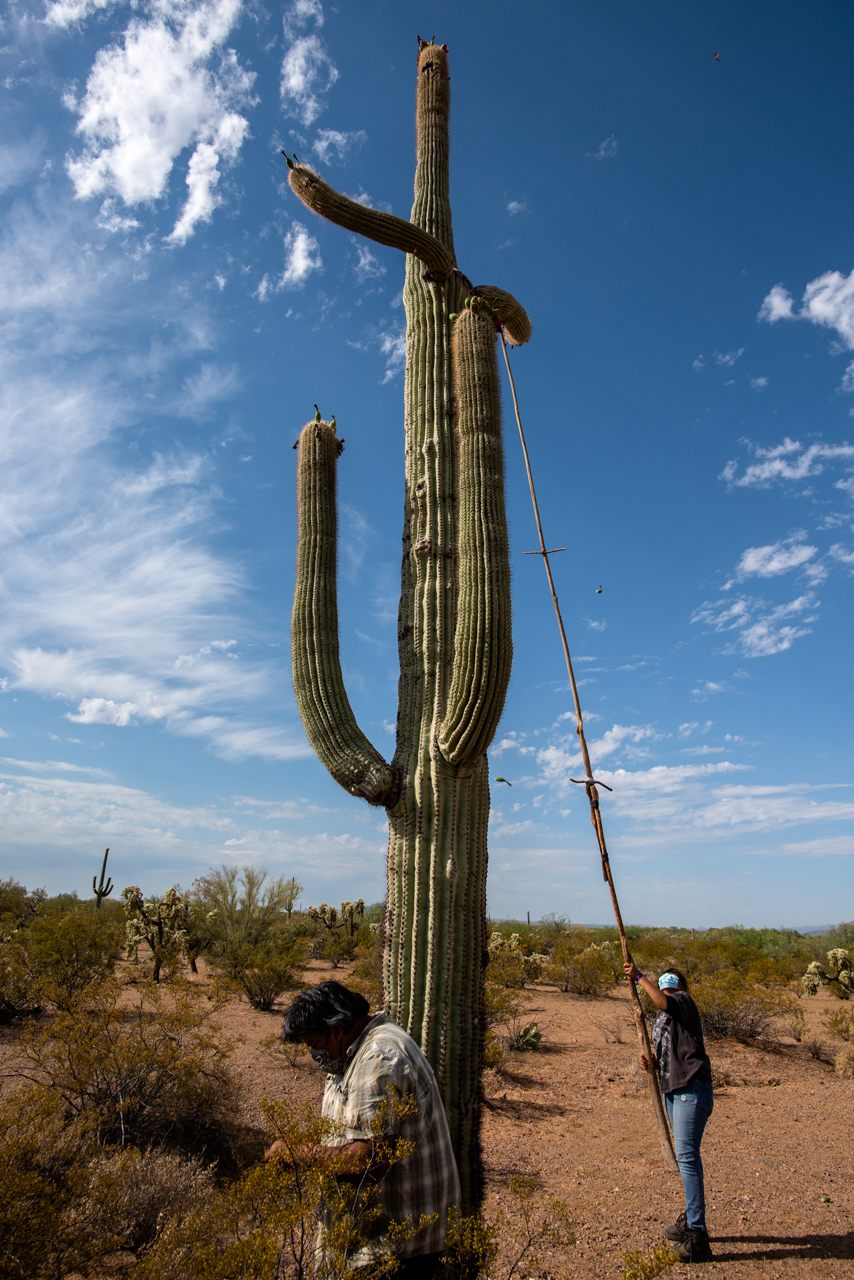
Tree pods, the fruit of smaller cactuses, leaves, seeds, shoots, and berries ripen in ephemeral spurts: barrel cactus after winter rain, prickly pear after the monsoon, and mesquite in between. Each mid-June, the saguaro fruit’s few brilliant weeks begin. One saguaro fruit has about 35 calories. One cactus can have dozens of fruits. And one south-facing slope can harbor a breath-stealing saguaro forest.
In ages past, Tohono O’odham migrated seasonally to the open desert for the saguaro-fruit harvest. Gathering mornings and evenings, they sliced fruit from cacti that can rise 50 feet, weigh 4,800 pounds, and live 200 years. Day after day, they harvested in small family camps, sheltering under ramadas made of stones, cactus ribs, and sticks. People ate until their fingers purpled. What they couldn’t eat, they turned into jam, dry paste, flour, cooking oil, drinks, syrup, vinegar, and wine.
Today, families like Noland’s could stay inside with electric fans twirling, eating strawberries picked by mistreated California workers and using “pancake syrup” born in giant cornfields. But Noland Johnson, his daughter Isabella Johnson, and his elder brother Terrol Dew Johnson prefer to embrace Tohono O’odham foods.
For decades, the Johnsons have done just that. Since 2000, Noland has managed the family farm, growing traditional crops such as corn, squash, beans, melon, and Tohono O’odham sugarcane. For 30 years, Terrol has been a soft-spoken proponent of traditional foods, though he has seen major setbacks: a shuttered café, a promising cultural-revitalization program ended. Still, the Johnsons persist. They persist because the saguaro-fruit harvest can reconnect Tohono O’odham with traditions and bolster food sovereignty, which ripples into other benefits, including better health and food security. Saguaro fruit, known as bahidaj in the Tohono O’odham language, sometimes called “the truffle of the desert,” is the most legendary and emblematic Tohono O’odham food, a sticky symbol of nature’s rhythmic bounty and renewal, one culled from a skyscraping, shiv-plated cactus out of the arid maw of the Sonoran during its immortal hot season.
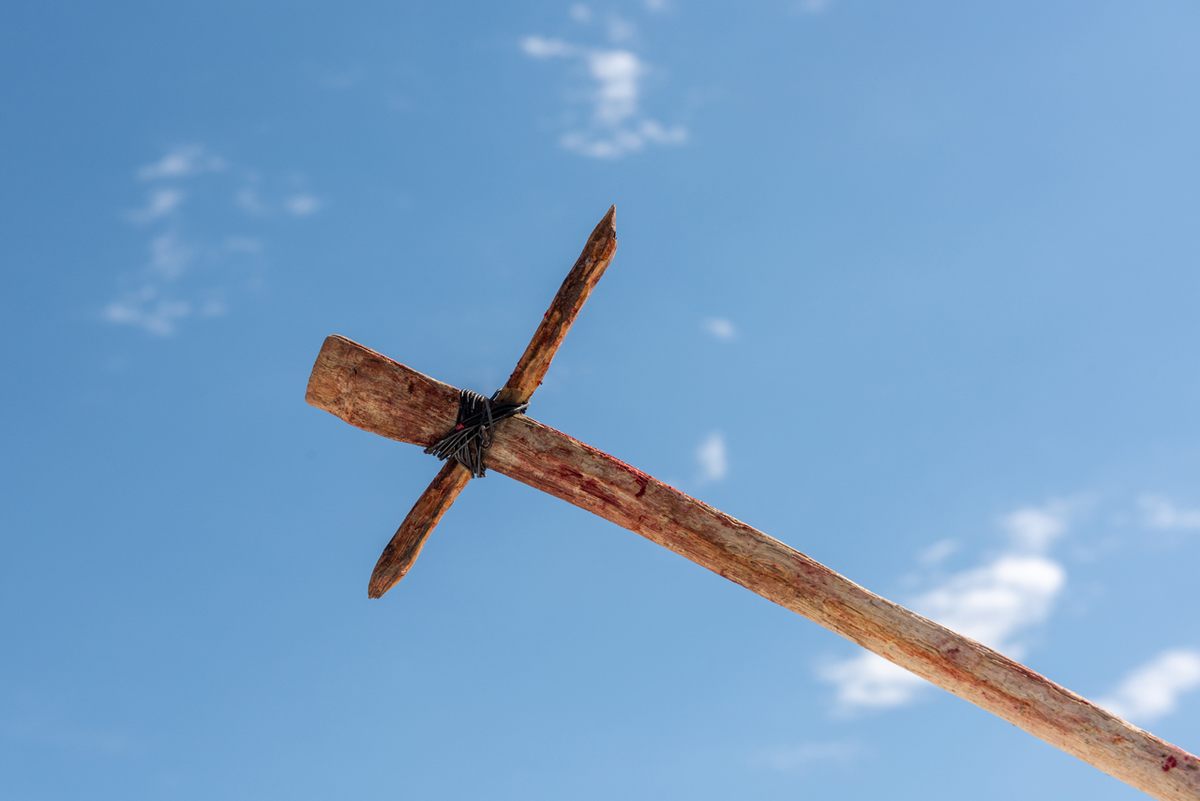
Driving into the desert from Sells, capital of the 28,000-member Tohono O’odham Nation, Noland keeps his two kuipad lashed to the truck. He and Isabella, 17, have been harvesting saguaro fruit every morning for about a week. “You wait until the birds and animals get the first picking,” Noland says. “You wait until you see the fruit turn red—two weeks after that.”
Noland parks on a lane between empty dirt fields, where he tinkers with a faulty roadside tractor. These are the 57 acres of farmland that Noland keeps with Terrol, an educator, activist, and basketry artist.
Every summer for three decades, the Johnsons have hosted a bahidaj camp on their farm, one of several similar camps in southern Arizona. Though attendance has recently dipped, as many as 300 Tohono O’odham typically come to theirs, many from homes where traditional foods were foreign and customs such as the bahidaj harvest had passed into history. Colonization and forced assimilation, including mandatory boarding schools for Native children run or funded by the U.S. government for nearly a century, wrenched tribe members from practices such as the saguaro harvest, a disconnect that the Johnsons and others, like San Xavier Co-op Farm, have long worked to mend.
“The hope was that if people came, they could go into their communities and organize harvesting trips and stuff,” Terrol later explains. “Now, a lot of people are growing up, and they’re interested in carrying it on.”
The bahidaj harvest and the saguaro wine ceremony that follow open the Tohono O’odham new year and “bring down the rain.” Following the harvest, Sonoran monsoons drench desert that has seen virtually no precipitation since late winter. Most of the year’s scant precipitation falls in weeks. Flood plains rush and foam. Once, Tohono O’odham farms used berms, canals, and drought-tolerant crops to steal a brief late-summer growing season. The Johnsons might run the only Tohono O’odham farm still using this Ak-Chin method today.
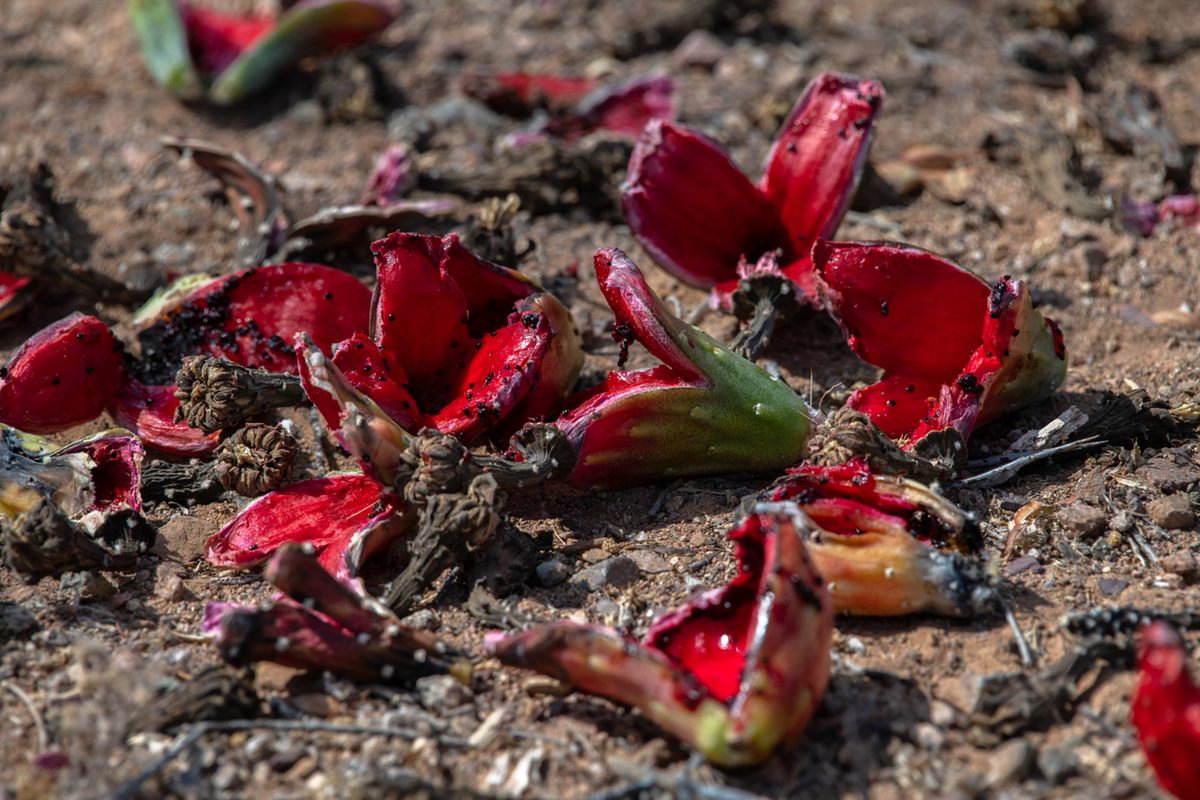
While many quarantined Americans planted seeds and rediscovered family recipes in the early days of the pandemic, youth on the reservation voiced a new interest in traditional desert foods. However, the Johnsons couldn’t convert this interest into immediate learning. They had to cancel this year’s camp due to a spike in Covid-19 infections in Arizona. Nonetheless, they will still harvest as a family.
In a way, this reflects Terrol’s experience with Tohono O’odham Community Action. For 30 years, he served as president of TOCA, which sought to revive Tohono O’odham traditions. Terrol held workshops about self-sufficiency, published a cookbook on ancient ingredients and cooking, and even walked across the country spreading nutrition knowledge to Indigenous communities along his 3,000 mile path. However, five years ago, his co-founder, a grant writer, left. Grant funding dried up, and Terrol labored to keep TOCA afloat. “I was left running a café, running the farm, running a magazine, running a gallery, and supervising programs we did with schools,” he recalls. “So we scaled back and disbanded everything and said let’s just focus on the farm and traditional foods.”
At last, Terrol appears on the family farm in his truck. “Are you ready to go, Noland?” he calls over to the roadside tractor.
Noland pockets his tools. “We’re ready.”
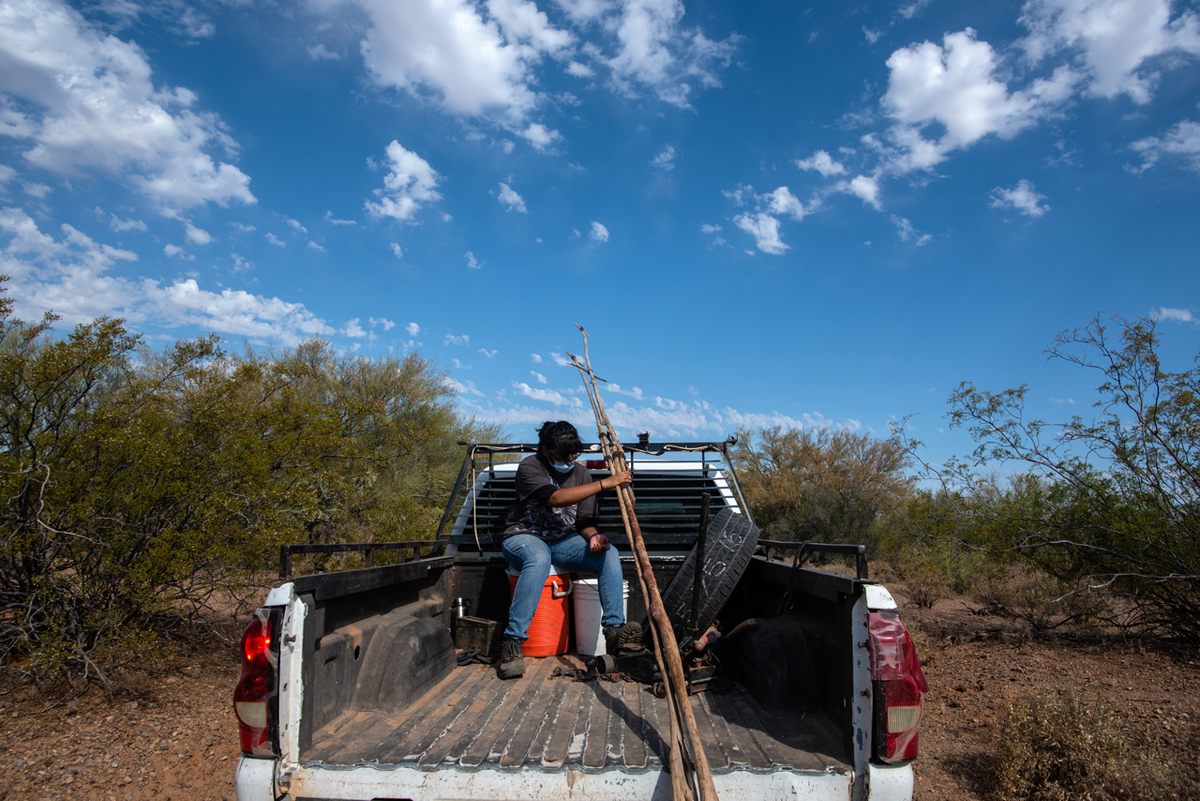
The two trucks take off, wending through tracts of mesquite and cholla clustering off the dusty pathways. Infinite space. Clouds sparse. Mountains nearing. After half an hour, Terrol and Noland park amid a saguaro forest overlooking a scrubby valley that sweeps into Mexico. Noland shoulders his kuipad, strolls to the first cactus.
All life on earth needs water. By definition, a desert is a place of water scarcity. This imbalance has in turn defined desert people of the world, including the Bedouin, Australian Aboriginals of the Great Victoria Desert, and the Mongolian tribes of the Gobi. Before metals, motors, and the groundwater pump, some desert survival tactics were astounding.
From roughly 400 to 1450, in what is now Arizona, the Hohokam developed the grandest irrigation system in the Western Hemisphere. Using canals near present-day Phoenix, they flooded some 100,000 acres of crops along the Salt and Gila Rivers, unlocking permanent agriculture.
The Hohokam were forerunners of the Akimel O’odham (“River People”), riparian neighbors to the Tohono O’odham (“Desert People”). Historically, life away from the Sonoran’s rivers was more nomadic. Tohono O’odham moved in family bands, hunting and gathering, following food and water. In winter, they lived near water sources in the mountains. In early summer, they left for the saguaro forests. Just before the monsoon, they moved to arroyos that would flood with stormwater, stealing a fleeting planting season. Desert life was demanding. People foraged roots, hunted and shared deer, and kept rooftop baskets of mesquite pods. Archaeologists have found bowls carved into remote rock—hollows once used to grind foraged mesquite and cactus seeds into bread flour.
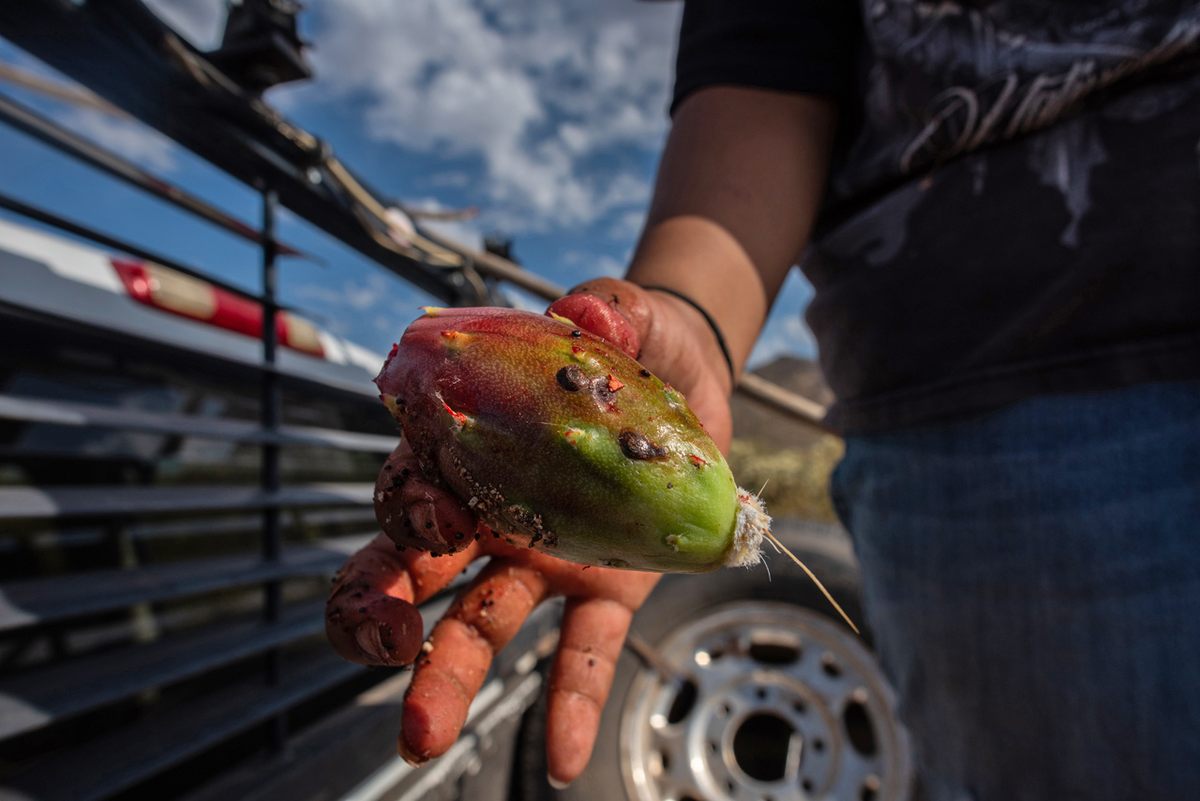
Centuries before trading posts, Tohono O’odham accessed crops beyond their limited growing capacity by trading saguaro syrup to Akimel O’odham farmers for corn, beans, squash, and wheat (once wheat was introduced by the Spanish). As recently as the 1930s, foragers still picked as much as 450,000 pounds of saguaro fruit a year.
Betty Pancho, Terrol and Noland’s mother, recalls the bahidaj harvest as a young girl. Her family took mule-drawn wagons to a camp in the foothills. “We would go early in the morning and pick,” she says, “then come back and rest, then cook and rest, and then go out again.”
At camp, young Betty hunted prairie dogs and quail.
She gathered wood, to fuel the saguaro-fruit cooking fire.
Afterward, her family returned to the farm that, together with their forage, they lived from. They sojourned back from a camp deep in the mountains, one not far from where Terrol and Noland choose to harvest today.
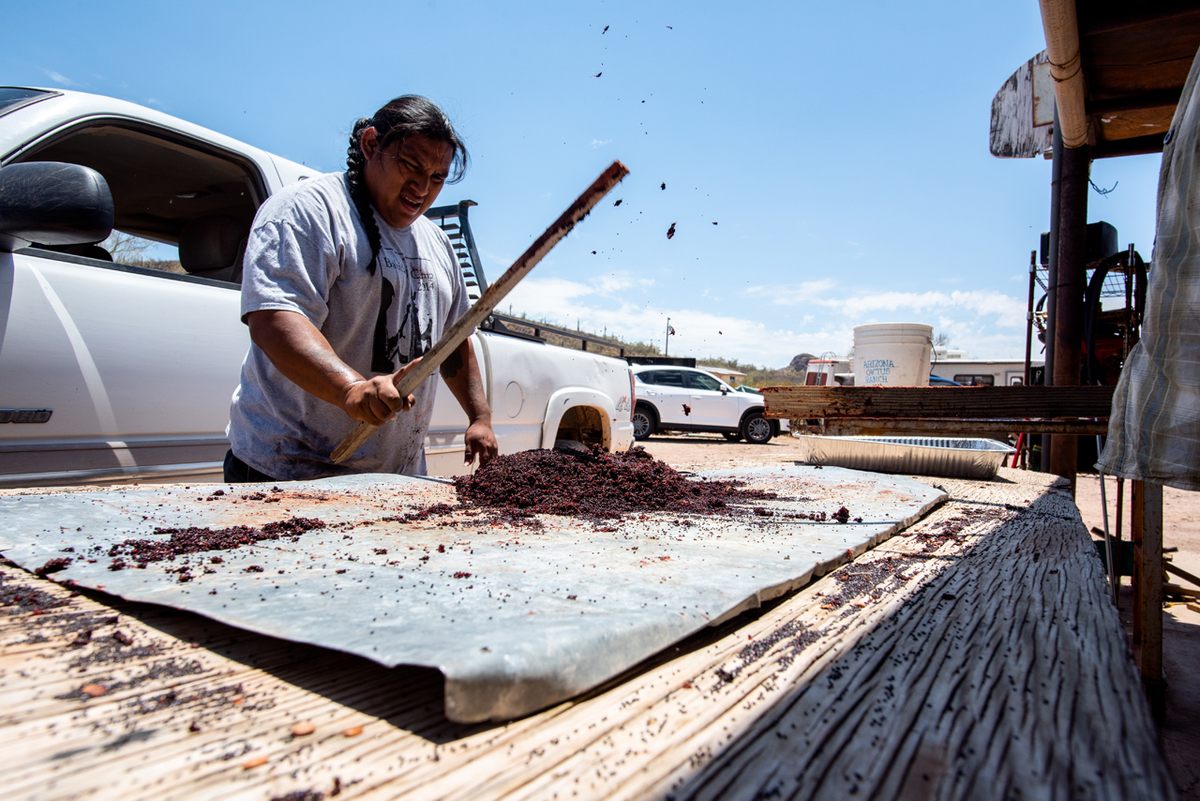
Noland guides his kuipad into the first crown of green, red, and purple. Columns of spines coat the cactus’s accordion-pleated skin. Like the postcards. Like the cartoons. Grand, evocative like an ageless oak, this first saguaro is just one of countless in the desert valley. Noland prods and hooks down fruit, often shearing many in one jerk. Below, tracking with a bucket, Isabella catches most. Thud, thud. Thud thud thud.
Ahead, saguaro march to the horizon. Some are old and yellow. Others show holes bored by Gila woodpeckers. Like people, saguaros are all vitally different: arms, size, fruit, holes, height, color, pleats, mien. Rising above the valley of jojoba, creosote, yucca, cholla, and gnarled trees, many saguaro are crowned with blushing fruit.
In under two minutes, Noland and Isabella harvest the saguaro with no damage, which is crucial, as Tohono O’odham see saguaro as people. Isabella then picks up a saguaro flower, yellow-and-white blooms that shrivel and harden like glass in the desert sun. “You use it for your knife,” Noland explains.
For cutting the ones that aren’t open, Isabella adds.

Noland slices a saguaro fruit with a saguaro flower. It opens. He scoops brilliant crimson flesh into his mouth and chews one of the world’s most amazing foods. “I try to get ‘em where they don’t fall out, just hook them,” he says.
Before you eat, Noland says to dip a finger in the fruit’s pulp and draw a cross on your bare chest. “They say that for your first harvest for the season, get it with your fingers and make—it’s not really a cross, it’s the four directions—on your heart, so you bless yourself,” Noland says. “This is really powerful. This is what’s going to bring the rain.”
Fresh, the edible jewel of the Sonoran tastes between strawberry and guava. It has a pop like a fig, but pulpier and far seedier. When naturally dried by the merciless sun (into what Noland calls a gu’e, pronounced “June”), the bursting of its seeds dominates, and the flavor turns wildly nutty, like some lost relative of peanut butter. At just 25 to 45 millimeters long, one fruit contains some 2,000 seeds.
“Actually, I end up eating more than half of what I pick,” Noland laughs.
Father and daughter move along, picking. Heat mounts. Sweat drips. Manna comes as plump fruit, wind gusts, clouds veiling the sun and the sight of the Baboquivari Mountains.
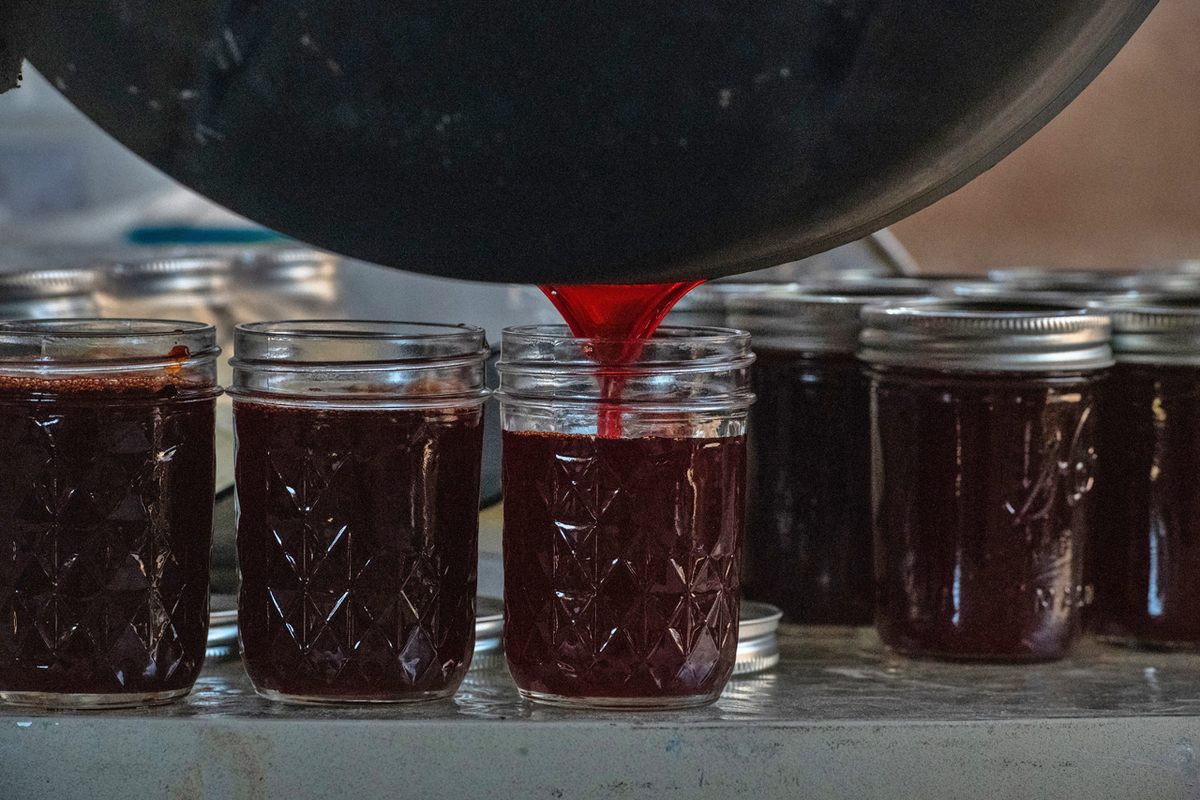
While others harvest, Terrol sits back, limited by a broken ankle.
When he was 10, Terrol, hindered in school by undiagnosed dyslexia, started weaving Tohono O’odham baskets with a teacher. “‘If you continue weaving and you become good, it will put food on your table and take you around the world,’” he says, remembering her words. “And she was right.” Today, Terrol is a globally acclaimed contemporary basketry artist now working on a two-story piece for the U.S. embassy in Paraguay. “I can weave with anything that can bend,” he says. “And if it doesn’t bend, I bend to it.”
His decades as a foods educator have seen bending—his own, that of his people’s interest, and even of the desert. Over the years, he believes, Sonoran plant cycles have changed with warmer temperatures. “Traditionally, we pick cholla buds at the end of March or early April, then we would pick saguaro fruit, then mesquite beans, and then prickly pear,” he says. “It was just one after another. But now, some of those don’t happen anymore. You can just tell that things are messing up.”
Bahidaj harvest participation has waned from the days of his mother’s youth to lows a few decades ago, then made a modest comeback with slightly more harvesters today. (Some harvesters seek bahidaj on ancestral lands now part of Saguaro National Park, as the park reaffirmed an agreement with the tribe in 2018 to permit gathering of some traditional plants.) Even so, Terrol estimates that no more than some 20 percent of Tohono O’odham pick. He laments, too, that just one Tohono O’odham village holds the saguaro wine ceremony. He used to attend three a year, including, for four years, one he ran in an abandoned village.
At his eatery, Desert Rain Café, Terrol made a push to reestablish Tohono O’odham foods, including saguaro seeds and jam, tepary beans, mesquite, and i:waki (a wild green known as “desert spinach”). “We were the only Native restaurant in Arizona that didn’t serve frybread,” Terrol says. After ending TOCA and closing the original Desert Rain five years ago, he opened a new Desert Rain branch in Ajo, Arizona. Like the bahidaj camp, it’s currently out of action due to the pandemic.
Does he fret about the saguaro harvest’s future? Yes, he says, “In the back of my mind.”
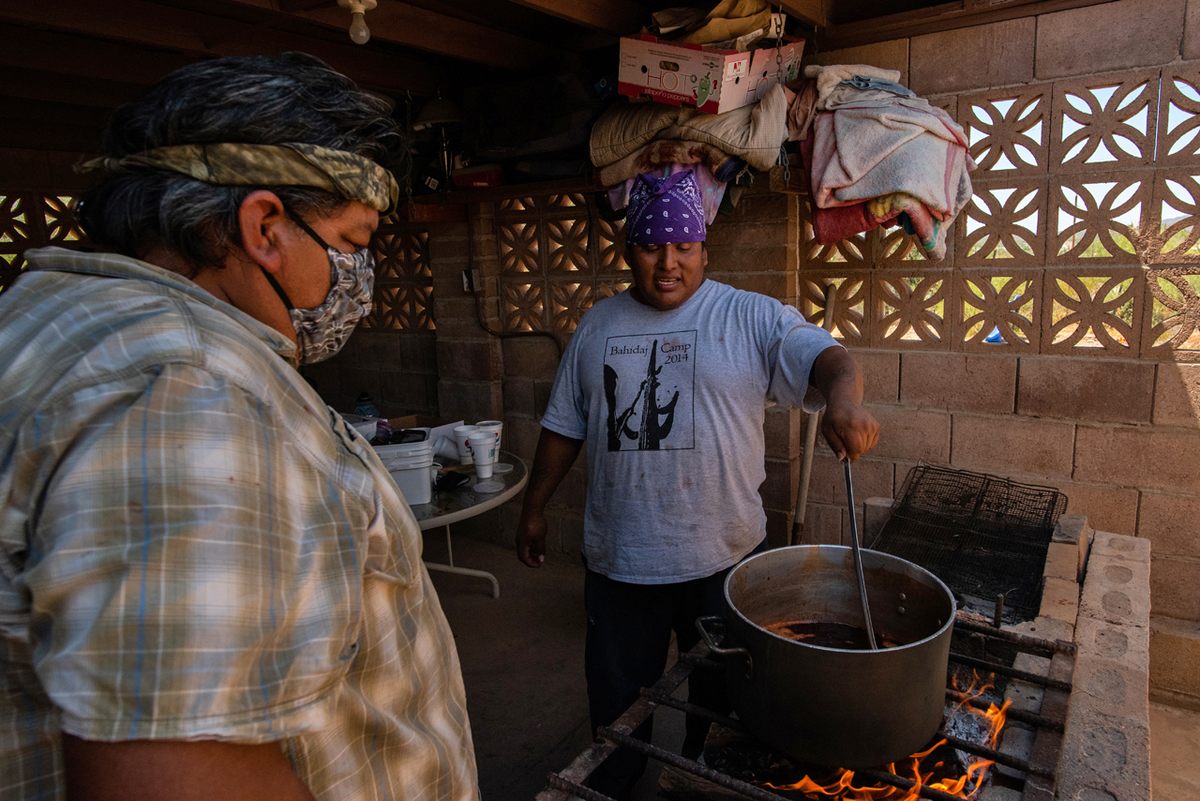
Noland and Isabella gather five gallons of fruit, good for a gallon of syrup. Later, family and friends stop by their home. Cooks stir the pot roiling with opaque red juice over mesquite fire. People sit, drink saguaro juice, eat frybread tacos, help, chat, and watch.
One is Betty Pancho. Since she was very young, fast food has come. Since she drove mules to camp, the Tohono O’odham tepary bean, a crop that can thrive on a single monsoon rain, went from staple to nearly vanished due to lack of interest in farming, a near-casualty of colonization and forced assimilation, just like so many traditional foods and practices. Today, the tepary bean has come back, and, in Terrol’s estimation, 150 to 200 families still go bahidaj picking.
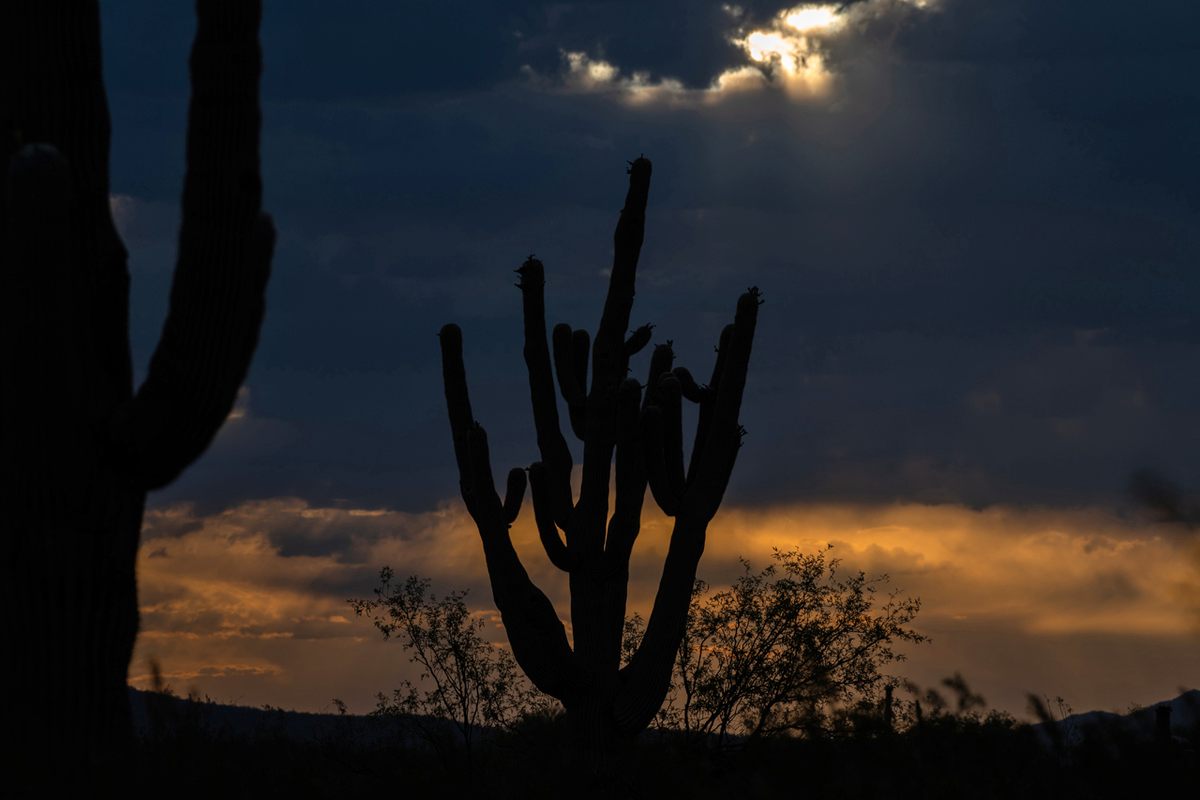
“When we started [camp] 30 years ago, hardly anybody was doing it,” he says. “Young people we taught back then, they now pick with families of their own.” This includes the family of Jesse Pablo, the burly, bandana-wearing stirrer of saguaro pulp outside the Johnson house, who strains magmatic juices using a torn corn sack and reduces them over hours, as Terrol once taught him, into ruddy syrup.
Today, the bahidaj harvest is more about tradition, enjoyment, good natural food, and extra income for those who sell syrup. Saguaro fruit isn’t needed for desert survival in 2020, but the survival of the saguaro-fruit tradition enriches Tohono O’odham life and culture in other ways. The ruby jewels remain treasured, a harbinger and celebration of the monsoon rains that make the Sonoran Desert, briefly and gloriously, lush and vibrant.
Gastro Obscura covers the world’s most wondrous food and drink.
Sign up for our email, delivered twice a week.











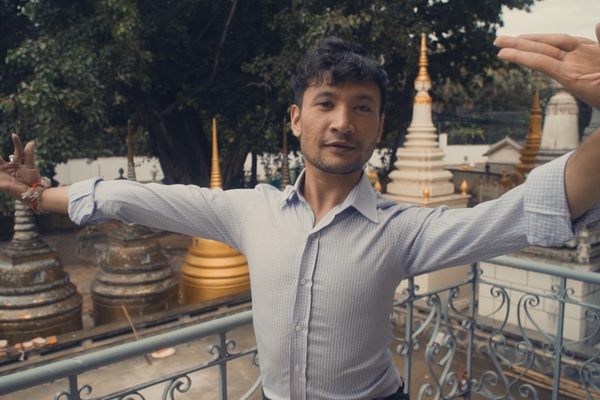





















Follow us on Twitter to get the latest on the world's hidden wonders.
Like us on Facebook to get the latest on the world's hidden wonders.
Follow us on Twitter Like us on Facebook